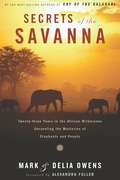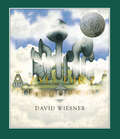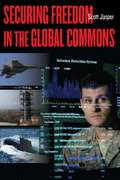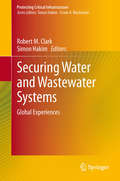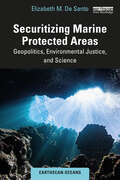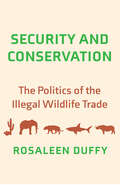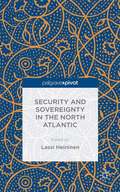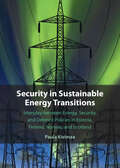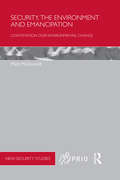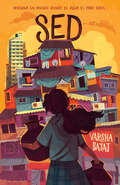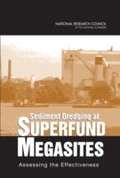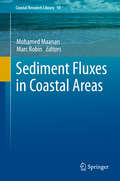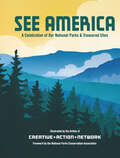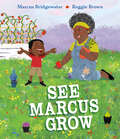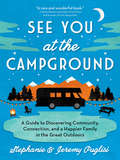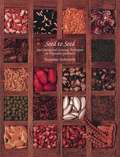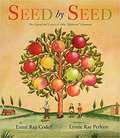- Table View
- List View
Secrets of the Savanna: Twenty-three Years in the African Wilderness Unraveling the Mysteries ofElephants and People
by Mark James Owens Cordelia Dykes OwensIn this riveting real-life adventure, Mark and Delia Owens tell the dramatic story of their last years in Africa, fighting to save elephants, villagers, and -- in the end -- themselves. The award-winning zoologists and pioneering conservationists describe their work in the remote and ruggedly beautiful Luangwa Valley, in northeastern Zambia. There they studied the mysteries of the elephant population's recovery after poaching, discovering remarkable similarities between humans and elephants. A young elephant named Gift provided the clue to help them crack the animals' secret of survival. A stirring portrait of life in Africa, Secrets of the Savanna is a remarkable record of the Owenses' unique passions.
Secrets of the Seasons: Orbiting the Sun in Our Backyard
by Kathleen Weidner ZoehfeldThe family from Secrets of the Garden are back in a new book about backyard science that explains why the seasons change.Alice and her friend Zack explore the reasons for the seasons. Alice's narrative is all about noticing the changes as fall turns into winter, spring, and then summer. She explains how the earth's yearlong journey around the sun, combined with the tilt in the earth's axis, makes the seasons happen. Alice's text is clear and simple, and experiential. Two very helpful—and very funny—chickens give more science details and further explanation through charts, diagrams, and sidebars. Packed with sensory details, humor, and solid science, this book makes a complicated concept completely clear for young readers—and also for the many parents who struggle to answer their kids' questions! "Several adults of my acquaintance . . . would find Secrets of the Seasons to be an eye-popping revelation." —John Lithgow, The New York Times Book Review
Sector 7
by David WiesnerThe Caldecott Honor–winning adventure of a young boy and a mischievous cloud in a funny, touching story about art, friendship, and the weather by three-time Caldecott Medalist David Wiesner. Only the person who gave us Tuesday could have devised this fantastic Caldecott Honor–winning tale, which begins with a school trip to the Empire State Building. There a boy makes friends with a mischievous little cloud, who whisks him away to the Cloud Dispatch Center for Sector 7 (the region that includes New York City). The clouds are bored with their everyday shapes, so the boy obligingly starts to sketch some new ones. . . . The wordless yet eloquent account of this unparalleled adventure is a funny, touching story about art, friendship, and the weather, as well as a visual tour de force.
Securing Freedom in the Global Commons
by Scott JasperThe new millennium has brought with it an ever-expanding range of threats to global security: from cyber attacks to blue-water piracy to provocative missile tests. Now, more than ever then, national security and prosperity depend on the safekeeping of a global system of mutually supporting networks of commerce, communication, and governance. The global commons-outer space, international waters, international airspace, and cyberspace-are assets outside of national jurisdiction that serve as essential conduits for these networks, facilitating the free flow of trade, finance, information, people, and technology. These commons also comprise much of the international security environment, enabling the physical and virtual movement and operations of allied forces. Securing freedom of use of the global commons is therefore fundamental to safeguarding the global system. Unfortunately, the fact that civil and military operations in the commons are inherently interwoven and technically interdependent makes them susceptible to intrusion. This intrinsic vulnerability confronts the international defense community with profound challenges in preserving access to the commons while countering elemental and systemic threats to the international order from both state and non-state actors. In response, the authors of this volume-a team of distinguished academics and international security practitioners-describe the military-operational requirements for securing freedom of action in the commons. Collaborating from diverse perspectives, they examine initiatives and offer frameworks that are designed to minimize vulnerabilities and preserve advantages, while recognizing that global security must be underscored by international cooperation and agreements. The book is written for security professionals, policy makers, policy analysts, military officers in professional military education programs, students of security studies and international relations, and anyone wishing to understand the challenges we face to our use of the global commons.
Securing Water and Wastewater Systems
by Simon Hakim Robert M. ClarkUrban water and wastewater systems have an inherent vulnerability to both manmade and natural threats and disasters including droughts, earthquakes and terrorist attacks. It is well established that natural disasters including major storms, such as hurricanes and flooding, can effect water supply security and integrity. Earthquakes and terrorist attacks have many characteristics in common because they are almost impossible to predict and can cause major devastation and confusion. Terrorism is also a major threat to water security and recent attention has turned to the potential that these attacks have for disrupting urban water supplies. There is a need to introduce the related concept of Integrated Water Resources Management which emphasizes linkages between land-use change and hydrological systems, between ecosystems and human health, and between political and scientific aspects of water management. An expanded water security agenda should include a conceptual focus on vulnerability, risk, and resilience; an emphasis on threats, shocks, and tipping points; and a related emphasis on adaptive management given limited predictability. Internationally, concerns about water have often taken a different focus and there is also a growing awareness, including in the US, that water security should include issues related to quantity, climate change, and biodiversity impacts, in addition to terrorism. This presents contributions from a group of internationally recognized experts that attempt to address the four areas listed above and includes suggestions as to how to deal with related problems. It also addresses the new and potentially growing issue of cyber attacks against water and waste water infrastructure including descriptions of actual attacks, making it of interest to scholars and policy-makers concerned with protecting the water supply.
Securitizing Marine Protected Areas: Geopolitics, Environmental Justice, and Science (Earthscan Oceans)
by Elizabeth M. De SantoThis book presents a novel examination of Marine Protected Areas within a security context, bridging science, policy, and geopolitics, and addressing the often-under-emphasized aspect of environmental justice.The book argues that Marine Protected Areas (MPAs) are not only a critical tool for protecting marine biodiversity in a changing climate, but they also play an important role at the intersection of geopolitics and environmental justice, and they provide a case study of environmental governance at the science-policy interface. The book takes an interdisciplinary and critical approach and builds on the author's two decades of experience working in this field. Geopolitically, it explores the ways in which MPAs provide footprints for influence and access to resources far from home for nations with overseas territories. MPAs also raise important issues connected to equity, environmental justice, and social justice, including access to resources and participation in environmental decision-making processes, key aspects for achieving long-term conservation goals. The book also demonstrates how MPAs are a critical lens for understanding how policy makers cope with scientific uncertainty, and the necessity of well-designed and precautionary science advisory processes. While the ecological contribution of MPAs is paramount, social issues and geopolitical considerations are often less obvious in the discourse underpinning MPAs, and the resulting tensions can undermine long-term conservation objectives. By applying the three lenses of geopolitics, environmental justice and science, this book provides key insights to help the international community moving past the 2030 biodiversity targets and beyond, towards a future of meaningful, equitable, and effective conservation approaches.This book will be of great interest to students and scholars of biodiversity conservation, marine studies, political geography, environmental governance, and science-policy studies. It will also be of interest to marine conservation governance professionals and policymakers.
Security Management for Occupational Safety (Occupational Safety & Health Guide Series #15)
by Michael LandHow far would or should you go to feel secure? While everyone wants safety and security, the measures to achieve it are often viewed of as intrusive, unwanted, a hassle, and limiting to personal and professional freedoms. Yet, when an incident occurs, we can never have enough security. Security Management for Occupational Safety provides a framewor
Security and Conservation: The Politics of the Illegal Wildlife Trade
by Rosaleen DuffyAn exploration of the scale, practical reality, and future implications of the growing integration of biodiversity conservation with global security concerns &“There are few keener observers of international biodiversity conservation than Rosaleen Duffy. With a ferocity of purpose, she investigates the tenuous connection and nuances among illegal wildlife trade, terrorism threats, and national security.&”—Steven R. Brechin, Rutgers University, New Brunswick Debates regarding environmental security risks have generally focused on climate change and geopolitical water conflicts. Biodiversity conservation, however, is increasingly identified as a critical contributor to national and global security. The illegal wildlife trade is often articulated as a driver of biodiversity losses, and as a source of finance for organized crime networks, armed groups, and even terrorist networks. Conservationists, international organizations, and national governments have raised concerns about &“convergence&” of wildlife trafficking with other serious offenses, including theft, fraud, corruption, drugs and human trafficking, counterfeiting, firearms smuggling, and money laundering. In Security and Conservation, Rosaleen Duffy examines the scale, practical reality, and future implications of the growing integration of biodiversity conservation with global security concerns. Duffy takes a political ecology approach to develop a deeper understanding of how and why wildlife conservation turned toward security‑oriented approaches to tackle the illegal wildlife trade.
Security and Sovereignty in the North Atlantic
by Lassi HeininenThe North Atlantic continues to be an area of international strategic significance regionally and globally. This study explores the strong processes of sovereignty, as well as new independent states and micro-proto-states that are forming in the region.
Security and the Environment
by Rita FloydIn 1993 the first Clinton administration declared environmental security a national security issue, but by the end of the Bush administrations environmental security had vanished from the government's agenda. This book uses changing US environmental security policy to propose a revised securitisation theory, one that both allows insights into the intentions of key actors and enables moral evaluations in the environmental sector of security. Security and the Environment brings together the subject of environmental security and the Copenhagen School's securitisation theory. Drawing on original interviews with former key players in United States environmental security, Rita Floyd makes a significant and original contribution to environmental security studies and security studies more generally. This book will be of interest to international relations scholars and political practitioners concerned with security, as well as students of international environmental politics and US policy-making.
Security in Sustainable Energy Transitions: Interplay between Energy, Security, and Defence Policies in Estonia, Finland, Norway, and Scotland
by Paula KivimaaBy providing a new qualitative analysis of policy coherence and integration between energy, security, and defence policies between 2006 and 2023, this book analyzes the impacts of policy interplay on energy transition through the lens of sustainability transitions research, security studies, energy security and geopolitics, and policy studies. The security aspects discussed range from national defence and geopolitics, to questions of energy security, positive security, and just transitions. Findings show that the policy interface around the energy-security nexus has often been incoherent. There is a lack of integration between security aspects, leading to ineffective policies from the perspective of decarbonisation and national security, which is evident in the European energy crisis following the war between Russia and Ukraine. This book is intended for researchers and experts interested in the energy transition and its connections to security and defence policies. This title is also available as Open Access on Cambridge Core.
Security, the Environment and Emancipation: Contestation over Environmental Change (PRIO New Security Studies)
by Matt McDonaldThis book offers an examination of the role of emancipation in the study and practice of security, focusing on the issue of environmental change. The end of the Cold War created a context in which traditional approaches to security could be systematically questioned. This period also saw a concerted attempt in IR to argue that environmental change constituted a threat to security. This book argues that such a notion is problematic as it suggests that a universal definition of security is possible, which prevents a recognition of security as a site of contestation, in which a range of actors articulate alternative visions of who or what is in need of being secured. If security is understood and approached in traditional terms - as the territorial preservation of the nation-state from external threat - then it is indeed difficult to see how environmental issues would benefit from being placed on states’ security agenda. If, however, security is defined in terms of the emancipation of the most vulnerable individuals from contingent structural oppressions, then drawing a relationship between environmental change and security may be beneficial for redressing those environmental issues and prioritising the needs of those most at risk from the manifestations of global environmental change. This book takes the limitations of contemporary approaches to the relationship between the environment and security as its starting point, and seeks to do two things. First, it aims to illustrate the ways in which arguments over approaches to environmental issues can be viewed as contestation over the meaning of 'security‘ in particular political contexts. Central here is the composition and assumptions of the dominant security discourse to emerge regarding those issues: a framework of meaning for the most important forms of action on behalf of a particular group, defining the terms for meaningful contestation and negotiation about security itself within that group. As such, the book attempts to illustrate the dynamics of competition over the meaning of security with reference to environmental issues, particularly focusing on instances of political change in the dominant security discourse through which that issue is approached. In the process the author points to the central role of these dominant security discourses in underpinning the most practically significant actions regarding environmental issues such as deforestation and global climate change. The book employs methodological tools that enable a focus on how particular frameworks of meaning are constituted and become dominant; how they provide a lens through which various issues are approached; and how discourses most consistent with redressing environmental change and the suffering of the most vulnerable might come to provide the framework through which security is viewed in particular contexts. This book will be of much interest to students of Critical Security Studies, geography, sociology, IR and Political Science in general.
Sed: Imagina un mundo donde el agua es para todos / Thirst
by Varsha BajajBestseller del New York Times. La fascinante historia de una niña heroica que pelea por su convicción de que el agua debería ser para todos. Minni vive en la zona más pobre de Bombay, donde el acceso al agua está limitado a unas cuantas horas al día y en las llaves comunales hay largas filas. Aunque, últimamente, hasta ese poco acceso se ve amenazado por terribles cortes en el suministro y ladrones que roban el preciado bien, un acto que Minni atestigua por accidente una noche. Mientras tanto, en el rascacielos donde acaba de empezar a trabajar, descubre que sale agua de cada grifo y hay incluso una alberca en la azotea. Pero Minni también descubre ahí a uno de los jefes de la mafia del agua. Ahora debe decidir si exponerlo y poner en riesgo su trabajo, y hasta su vida. ¿Cómo algo tan sencillo como tener acceso al agua puede ser tan complicado?
Sediment Dredging at SUPERFUND MEGASITES: Assessing the Effectiveness
by National Research Council of the National AcademiesThe National Academies Press (NAP)--publisher for the National Academies--publishes more than 200 books a year offering the most authoritative views, definitive information, and groundbreaking recommendations on a wide range of topics in science, engineering, and health. Our books are unique in that they are authored by the nation's leading experts in every scientific field.
Sediment Fluxes in Coastal Areas
by Mohamed Maanan Marc RobinThis book presents a detailed analysis and synthesis of the processes affecting sediments fluxes from watershed to worldwide coastal systems. The volume provides a comprehensive overview and constitutes a systematic description of the response of coastal systems to global and local changes, like climate change, sea level, land use and land cover change. The case studies cover a sequence of coastal environments such as lagoons, bays, estuaries, deltas and beaches. Sediment Fluxes in Coastal Areas is designed for researchers, professionals and for course-use in hydrology, oceanography, geography, geology, geomorphology and environmental science.
See America: A Celebration of Our National Parks & Treasured Sites
by Creative Action NetworkIn homage to America’s National Parks and their iconic art posters, this volume features new artwork for seventy-five parks and monuments across all fifty states.“In this sepia-tinged homage” to the iconic National Parks posters “modern artists contribute dazzling new graphics” (Entertainment Weekly).From 1935 to 1943, the WPA’s Federal Art Project hired American artist to create posters celebrating the National Parks Service. The icon See America posters inspired Americans to fall in love with the country’s landmarks and wild spaces from the Golden Gate Bridge to the Gateway Arch and from the Grand Canyon to the Great Smokey Mountains.Originally published to coincide with the centennial anniversary of the National Parks Service, the Creative Action Network has partnered with the National Parks Conservation Association to revive and reimagine the legacy of WPA travel posters. Artists from all over the world participated in the creation of this new, crowdsourced collection of See America posters for a modern era.
See How They Grow: Forest (See How They Grow)
by DKSee how young forest animals grow and change in the first weeks and months of their lives with this educational children&’s book series for little nature lovers.Meet a playful squirrel, a furry fox, and a delightful deer fawn and watch how they grow. Exquisite photography captures and follows the early lives of children&’s favorite woodland animals.This series of animal books for children boasts: • Three 24-page books, each including five different young animals at different stages of their early lives • Will instill in young readers a lifelong love of animals, nature and books • The books in this series may be bought individually or packaged together in an elegant, durable slipcase Everyone loves little animals and this educational book is a must for fans of furry forest creatures and would make an excellent children&’s gift. Elegant and filled with beautiful photography, children can follow baby animals through their early lives — from helpless newborns to confident, curious creatures on the cusp of adulthood.A series of photographs show each animal at different stages in its early life. See an owl hatch from its egg, a mouse before it has fur, and foxes learning to hunt. These books are a delight to read together or aloud to preschool children or for young readers to pick up themselves, which has many early learning benefits including language development. Perfect for children ages 3–5, this nature book captures in beautiful detail how children&’s favorite forest animals grow and develop. Learning about how animals grow and change is a topic often covered as part of the early childhood and kindergarten curriculums. Want to gift your little one the full book set? Add See How They Grow: Farm Animals and See How They Grow: Pets to complete the set.
See It with a Small Telescope: 101 Cosmic Wonders Including Planets, Moons, Comets, Galaxies, Nebulae, Star Clusters and More
by Will KalifHave Fun Exploring the Stars with Close-up Views of Space Objects Right from Your Own BackyardTake the mystery and struggle out of discovering new worlds. With hands-on tips, tricks and instructions, this book allows you to unleash the full power of your small telescope and view amazing space objects right from your own backyard, including:• Saturn&’s Rings• Jupiter&’s Moons• Apollo 11's Landing Site• Orion Nebula• Andromeda Galaxy• Polaris Double Star• Pegasus Globular Cluster• And much, much more!
See Marcus Grow
by Marcus BridgewaterMarcus Bridgewater, also known as the social media sensation Garden Marcus, shows kids the lessons he learned in his grandma's garden when he was growing up.Grandma's favorite place is her garden. It seems like she could stay there forever! Marcus wants to know why--so they set about exploring it together. From shells protecting seeds (like Marcus's helmet protects his head!) to a small seed eventually growing into something big (also just like Marcus!), there are so many amazing connections to be made in this wonderful place. Day after day, Marcus delights in realizing how much he has in common with the plants--he drinks water every day, too, and he gets haircuts just like the plants get pruned. As his grandma says, there's a whole world to explore in a garden, and Marcus likes thinking about it as a playground for all the snails, birds, bugs, and worms. And one of its many beauties is the bounty they are rewarded with after all the love and care they pour into it!
See You Soon, Samantha
by Lara BergenFollow best friends Liza, Samantha, and Mina as they spend their first summer apart--and try to find the perfect souvenirs for one another. Without her friends, Samantha feels lost at the beach, but maybe that's where she'll find herself.
See You at the Campground: A Guide to Discovering Community, Connection, and a Happier Family in the Great Outdoors
by Stephanie Puglisi Jeremy PuglisiA family-friendly guide for camping with kids and infants — because the best memories are the ones made around the campfire.Road trips with kids aren't easy, but new parents of twins Stephanie and Jeremy Puglisi became experts at creating lasting family memories without breaking the bank. Whether you're new to camping or a seasoned pro, hit the road with Stephanie and Jeremy, hosts of the popular The RV Atlas podcast, as they show you the different ways that camping can lead to a happier, healthier family. From hiking with infants to navigating RV camping in state parks and camping in national parks—these outdoor lovers have tried it all, and See You at the Campground is a beautifully illustrated camping book for adults packed with personal anecdotes, packing lists, site recommendations, and recipes that will help you create a one-of-a-kind vacation on a family-friendly budget.Tips include:Reasons camping vacations are betterBuying an RVTrip planning tipsRoad trip tipsCampground etiquetteCamping with family and friendsNational park adventuresThe perfect resource for parents—and a great gift for campers at any level—this is the ultimate family vacation book to bring the family closer every time you set up camp—whether it's in a cabin, tent, or RV.
Seecatch: A Story of a Fur Seal
by Rutherford MontgomeryThis book tells the story of a young fur seal called Seecatch. He is born on St. Paul Island off the coast of Alaska, where many seals go each year to spend the summer on land, though in other seasons they travel the world, living entirely in water. Seecatch learns about the world, his enemies, and finding food, and each year he returns to his home, until he is large and old enough to find his own spot on the island to start his family.
Seed To Plant (National Geographic Kids Readers #Level 1)
by Kristin Baird Rattini National Geographic Kids StaffKids see plants, flowers, and trees around them every day. In this lively and educational reader, they'll learn how those plants grow. Kids will take this magical journey from seed pollination to plant growth, learning about what plants need to thrive and grow with the same careful text, brilliant photographs, and the fun approach National Geographic Readers are known for.
Seed To Seed: Seed Saving And Growing Techniques For The Vegetable Gardener
by Suzanne Ashworth Kent WhealySeed to Seed is a complete seed-saving guide that describes specific techniques for saving the seeds of 160 different vegetables. This book contains detailed information about each vegetable, including its botanical classification, flower structure and means of pollination, required population size, isolation distance, techniques for caging or hand-pollination, and also the proper methods for harvesting, drying, cleaning, and storing the seeds. Seed to Seed is widely acknowledged as the best guide available for home gardeners to learn effective ways to produce and store seeds on a small scale. The author has grown seed crops of every vegetable featured in the book, and has thoroughly researched and tested all of the techniques she recommends for the home garden. This newly updated and greatly expanded Second Edition includes additional information about how to start each vegetable from seed, which has turned the book into a complete growing guide. Local knowledge about seed starting techniques for each vegetable has been shared by expert gardeners from seven regions of the United States-Northeast, Mid-Atlantic, Southeast/Gulf Coast, Midwest, Southwest, Central West Coast, and Northwest.
Seed by Seed: The Legend and Legacy of John "Appleseed" Chapman
by Esme Raji Codell<p>His real name was John Chapman. He grew apples. <p>But wait. So what? Why should we remember him? And read about him? And think about him? And talk about him today, more than two hundred years after he was born? Why should we call him a hero? <p>Esme Raji Codell and Lynne Rae Perkins show us, in eloquent words and exhilarating pictures, why Johnny Appleseed matters now, perhaps more than ever, in our loud and wired and fast-paced world.</p>
